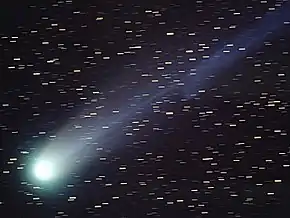114P/Wiseman–Skiff
114P/Wiseman–Skiff is a periodic comet in the Solar System.
| Discovery | |
|---|---|
| Discovered by | Jennifer Wiseman Brian A. Skiff |
| Discovery date | December 28, 1986 |
| Alternative designations | 1986 Y1; 1987b; 1993 IX; 1993u; 1993 X2 |
| Orbital characteristics A | |
| Epoch | May 28, 2013[1] |
| Aphelion | 5.5124 AU |
| Perihelion | 1.5748 AU |
| Semi-major axis | 3.5436 AU |
| Eccentricity | 0.55558 |
| Orbital period | 6.67 a |
| Inclination | 18.284° |
| Last perihelion | January 14, 2020[2] May 13, 2013[3] September 13, 2006 |
| Next perihelion | 2026-Sep-15 (JPL Horizons last obs 2020-05-14) |
It was discovered by Jennifer Wiseman in January 1987 on two photographic plates that had been taken on December 28, 1986, by Brian A. Skiff of Lowell Observatory. Wiseman and Skiff confirmed the comet on January 19, 1987.
Comet 114P/Wiseman–Skiff is believed to have been the parent body of the first meteor photographed from Mars.
References
- "Elements and Ephemeris for 114P/Wiseman-Skiff". Archived from the original on 2016-03-03. Retrieved 2011-05-26.
- "114P/Wiseman-Skiff Orbit". Minor Planet Center. Retrieved 2014-06-17.
- 114P at Kazuo Kinoshita home page
This article is issued from Wikipedia. The text is licensed under Creative Commons - Attribution - Sharealike. Additional terms may apply for the media files.

